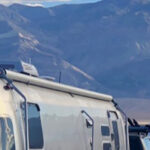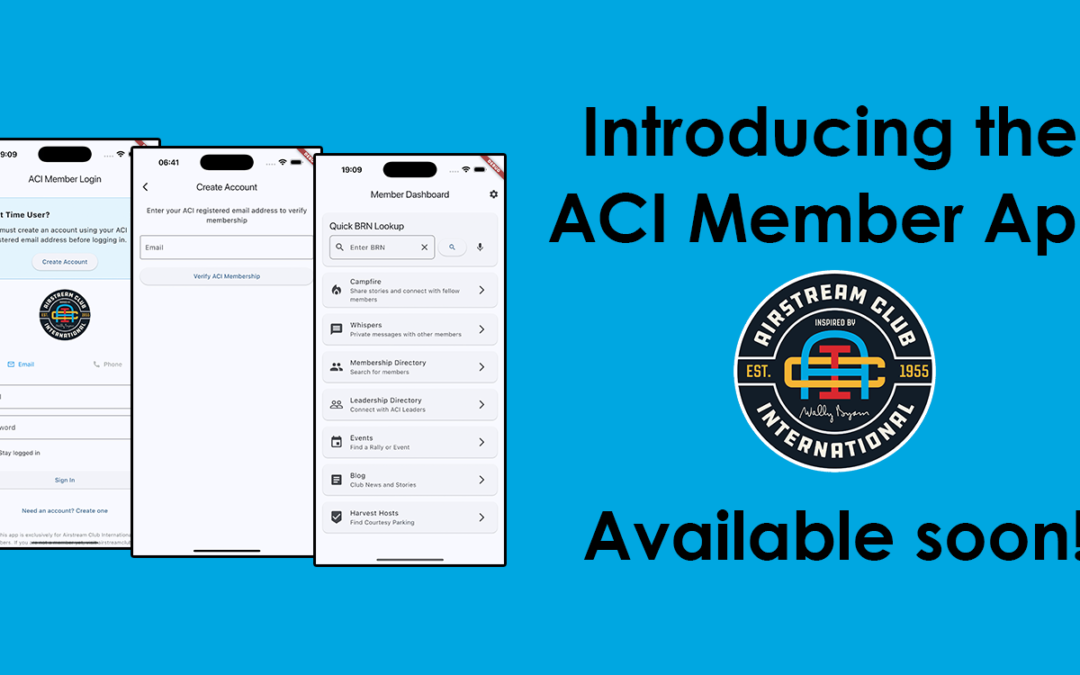By John Eckardt, BRN 7352
At the July International Airstream Rally in Fryeburg, Maine, one likely saw all of the bicycles that campers brought with them to get from their trailers to activities.
Of the bicycles I saw, I estimated that about 40% were electric.
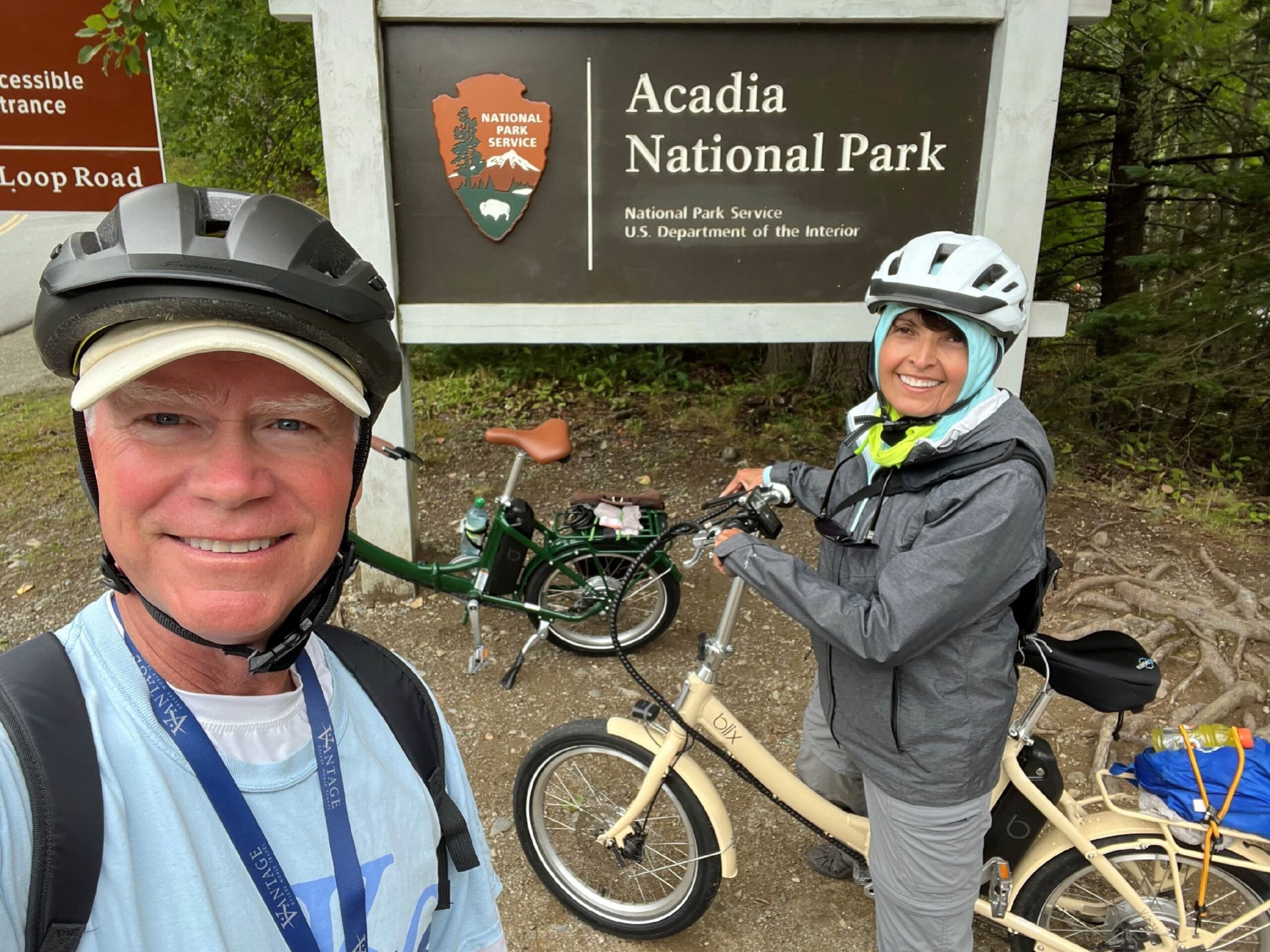
John Eckardt, and his wife Maria, at Acadia National Park in Maine
My wife and I had two of them. A few months prior to the rally we bought two foldable, lightweight, Blix Vika+ Flex bicycles. The color of my wife’s was Nu Cream and mine was British Racing Green.
Why e-bikes?
I bought electric bikes because I not only wanted to use them at the Rally, but also on our planned extended trip to Acadia National Park and Martha’s Vineyard in Massachusetts. Prior to the trip, I read that between 1919 and 1931, John D. Rockefeller Jr. funded and supervised the addition of 45 miles of crushed rock carriage roads in Acadia National Park. It was stipulated that these roads could only be used by horse-drawn carriages, pedestrians and bicyclists. Riding bikes at Acadia was one of our anticipated activities on the trip. Our new electric bikes turned out to be great for the Rally, Acadia and Martha’s Vineyard (mostly).
Another reason we bought electric bikes was because my wife and I both enjoy camping in state parks and we use the bikes to explore the parks. The problem we had in state parks with our regular bikes was the typical location of the campgrounds. We found too often that campgrounds were on top of a hill and the park amenities were at the bottom. Peddling back up those hills to the campsite kept getting harder. Now, after about six months of electric bike ownership, we both agree that the purchase — $1,800 for each — was a good decision.

John installed a Fiamma bike rack on the Airstream to transport the bikes
Transporting the bikes
For transporting the bicycles to the campground, I accepted the recommendation from Airstream, and installed a Fiamma bike rack for Airstream trailers on the back of the trailer. The Fiamma bike rack is the only one endorsed by Airstream. It cost about $600 and was listed as being able to support 100 lbs. The rack itself is about 20 lbs. and since I needed to carry two bikes, I assumed I would need to buy a bike that was close to 40 lbs.
To transport the bikes to the biking location after we were camped, I decided that our best option was to look for foldable bikes and store them for transport either in the bed of the truck or in the back seat area with the seats raised. We have a truck bed topper that is even with the roof height of the cab; I hoped that if I bought foldable bikes, I would not have to bring and store a separate bike carrying rack for the back hitch of the truck. Truck bike racks are typically heavy, clunky and take up a lot of valuable storage space. I have seen others carrying bikes on the front, back or top of the truck. I’ve also seen bikes with the front tires removed and carried upright in the truck bed. No options seemed to be convenient, but I decided to go with foldable bikes, mostly due to the transportation issue. That was a big decision because typically, foldable bikes have smaller tires and are lighter, but do not ride as smoothly or efficiently as standard sized bikes.
I read reviews where owners of boats or airplanes would carry foldable e-bikes due to storage limitations and foldable bikes seemed to work for them. Camping seemed similar enough to those uses.

The two Blix Vika+ Flex bicycles helped John and Maria travel at the International Rally, as well as trips to Acadia National Park and Martha’s Vineyard
Bike classes
When purchasing an e-bike, one needs to make a decision on the “class” of bike and size of electric motor. The National Park Service (NPS) provides the following definitions for e-bikes.
• Class 1 e-bikes have a motor that provides assistance only when the rider is pedaling, and that ceases to provide assistance when the e-bike reaches 20 mph.
• Class 2 e-bikes have a motor that may be used exclusively to propel the bicycle and that is not capable of providing assistance when the e-bike reaches 20 mph.
• Class 3 e-bikes have a motor that provides assistance only when the rider is pedaling and that ceases to provide assistance when the e-bike reaches 28 mph.
The NPS also states that the park superintendent has the authority to restrict speeds and/or throttle only biking depending on circumstances, so it’s always best to check before riding in certain locations especially when throttle-only biking is expected.
Maximum bike speeds are dependent on many things but mostly on the size and type of electric motor in the bike. How the electric motor works to propel the bike is a head spinning research event only a mechanical engineer could love.
What I found is that the options in available motors will lie somewhere between a 250 and 750-watt motor. The Jetson Bolt folding bike which sells at Costco for under $400, has a 350-watt motor and 14-inch wheels. Most mountain bikes will have a 750-watt motor. One will also need to choose between a hub motor and a mid-drive motor. Hub motors are typically located in the center wheel hub of the back wheel. Mid-drive motors are located at the center of the bike, between the pedals. Hub motors are lighter and considered more reliable and easier to use.
Generally, if one plans to use their bikes on short recreational rides of 10-15 miles, a 250-350 watt motor will be a lighter option and likely be large enough. For longer rides of 20-40 miles, or commuting, a 500-watt motor may be more appropriate. Mountain biking, longer trips or riding speeds of up to 28 mph may be best with a 750-watt motor.
My wife and I are recreational, scene-enjoying bicyclists. Our bike speeds are typically between 8 and 15 mph. On occasional stretches up or down a hill, we can accelerate up to 20 mph. Twenty miles per hour is fast for us on any bike, let alone a foldable bike with 20-inch tires. The motor on our Blix Vika + Flex is a 500-watt, geared motor, with a companion 48-volt battery. This combination seems plenty for us. We have been on a few 35-mile rides while using constant pedal assist and have had plenty of battery supply remaining at the end of the ride. You don’t want to be 10 miles away from home with no battery supply left and have to ride home the old-fashioned way! Yikes.
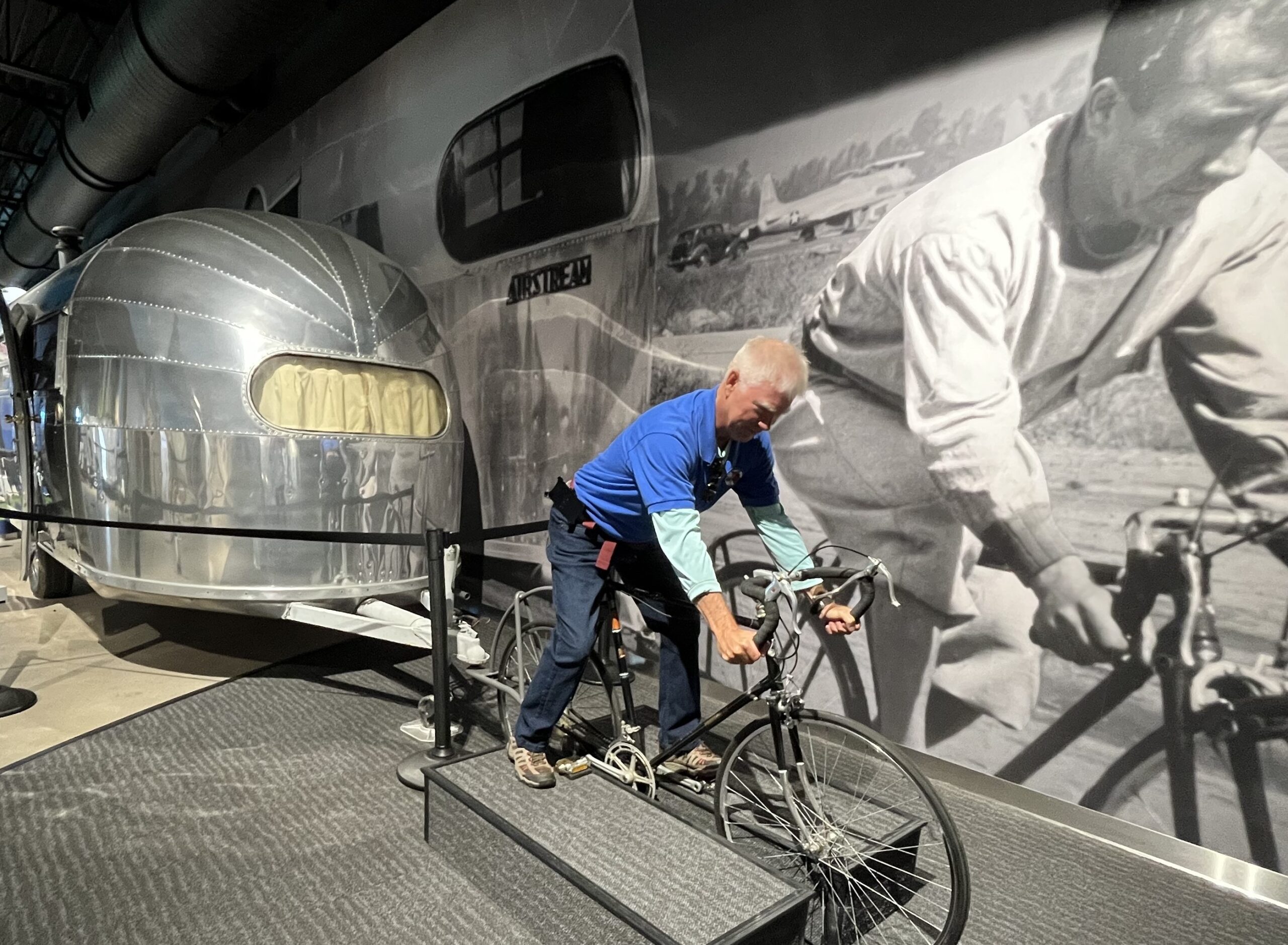
John “rides” the bike on display at the Airstream factory in Jackson Center, Ohio
Features of the bike
I wanted a bike with multiple gears, multiple power assist modes and a throttle. The throttle works easily. When one gently pushes the throttle thumb lever, the bike begins to accelerate. I often use the accelerator to start the bike — just to get moving — and then begin peddling. I also often use the accelerator up hills or when I start to get tired. When using the accelerator, the bike acts more like a motorcycle than a bicycle so one has to be careful.
Since we have a Class 2 bike, our bikes only reach a maximum speed of 20 mph. Our bikes have seven gears and five pedal assist modes. I’ve found that on most rides which include hills, I use all seven gears. Our bikes also have five pedal assists modes. Pedal assist gives the rider an extra boost whenever the rider pedals the bike. On our bike, pedal assist one, helps the bike accelerate to a speed of about 10 mph and will keep that speed constant, as long as the rider is pedaling. When the pedaling stops or when the brakes are engaged, the pedal assist action stops and the bike coasts. Pedal assist two accelerates the bike to about 12 mph. This pattern continues until the maximum pedal assist five, which tops out for us at 20 mph. The pedal assist five on a bike with a 750-watt motor would top out at 28 mph.
I didn’t want to worry about flat tires and I wanted a responsive ride with a little cushion. The bikes we ended up with had 20-inch wheels — but the tires were 2.4 inches wide, a little wider than normal, but not too wide. Tires get up to 4 inches wide. Bikes with 4-inch wide tires are often purchased for trail riding or mountain biking. I found that most bikes with 4-inch-wide tires were too heavy for my need. The 2.4-inch-wide tires I ended up with seemed about right and were advertised as having puncture resistant Kevlar technology. That sounded pretty good to me.
After seeing multiple online bike reviews, I also wanted several other aspects on our bikes like: disc brakes, for long-lasting and immediate stopping power; LED headlights and brake lights, for visibility at night, both in front and behind; fenders, so when we rode in an unexpected rainfall, we would not get the “waterline of shame” up our backs; a good digital display on the handlebars, so we could keep track of the number of miles we’ve ridden as well as to keep track of our battery life and bike speed; a pedal kickstand mounted back far enough on the frame so the pedal could not contact it when the kickstand was down and the pedal was moving. The last aspect our bikes have is step-through frames. Yes, step-through frames “used” to be for girls and women; I’m getting older and I like it.
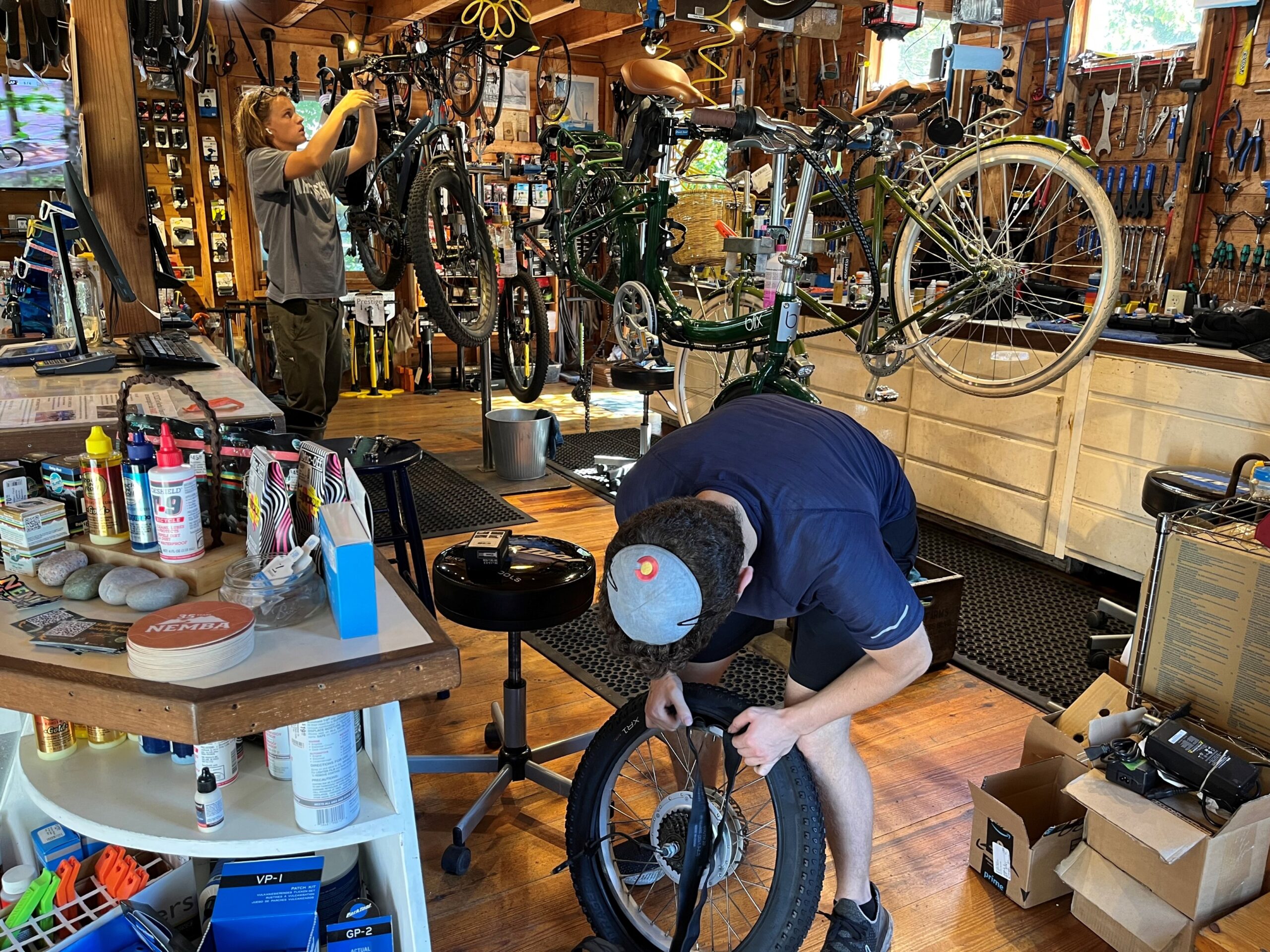
The mechanic at Edgartown Bicycycles in Massachusetts helped get John and Maria back on the road following a blown tire
Put in a tough spot
There you have it! All laid out on the near-perfect bikes for my wife and me. What could possibly go wrong? You may have noticed that I haven’t spoken about customer service. Well, remember the trip I spoke of earlier to Martha’s Vineyard? The 40-mile drive from Plymouth to Woods Hole, the four-mile bike ride from our parking lot to the Woods Hole Ferry, the 45-minute ferry ride from Woods Hole to the town of Vineyard Haven on Martha’s Vineyard? I was already tired at this point.
After departing the ferry, we rode the bikes about four miles over to the town of Oak Bluffs and then another eight miles down the coast to Edgartown. What a wonderful ride down the Joseph Silvia State Beach Road with great views of the beaches and Nantucket Sound to the left. Then, while getting to our farthest point away from home prior to turning back, we rode through the small town of Edgartown, which has a population of around 500 residents.
While cruising along one of the residential back roads of Edgartown, I felt an unfamiliar and unwanted wabble in the base of the back tire. Never good. Then — boom! Like a shotgun blast. Maria turned around on her bike. I was ghost white with that “oh no” sinking feeling of how far away from a solution I was. The tire was flat. Of course, the bike would not ride, and was even hard to push.
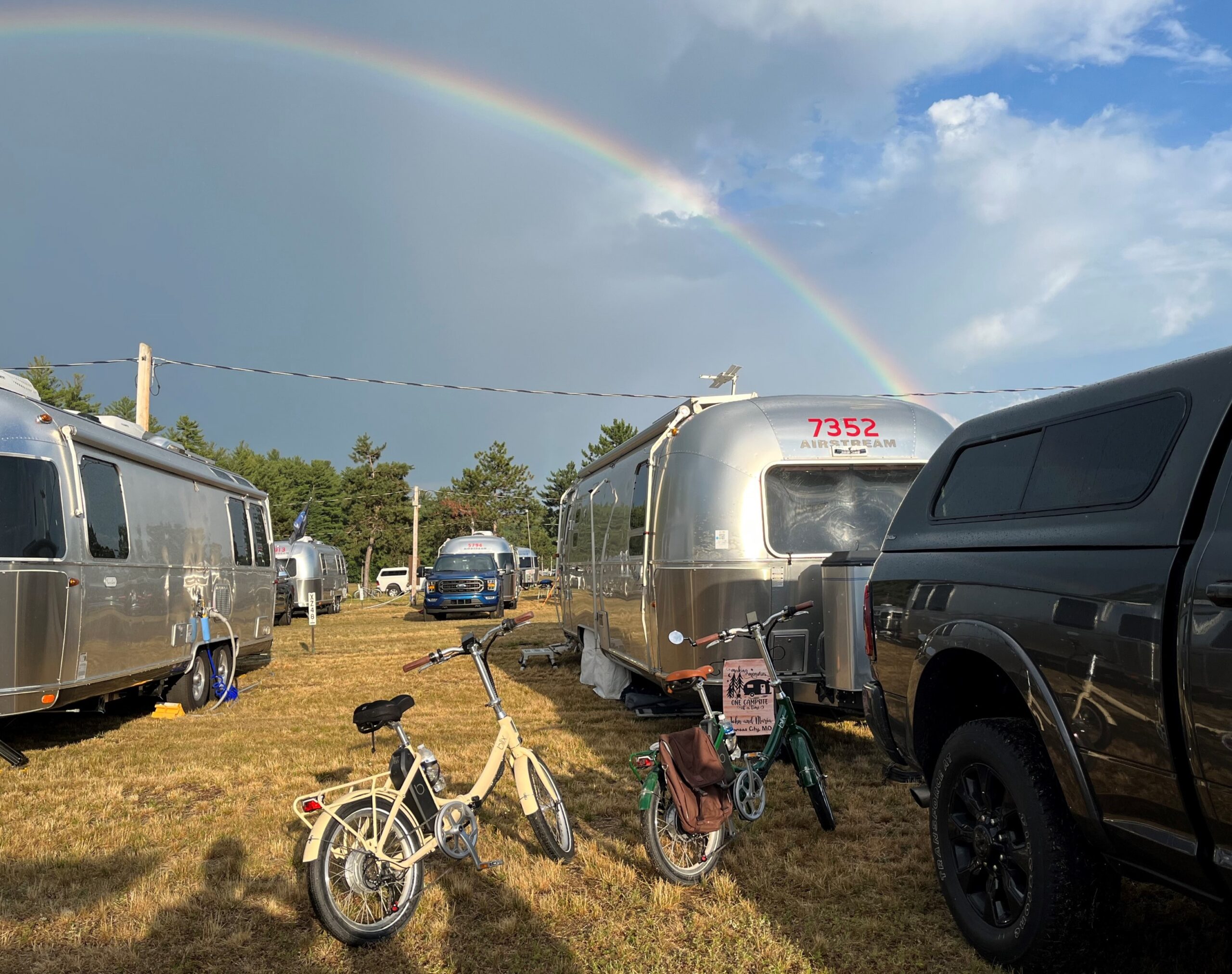
A rainbow encompasses the couple’s Airstream trailer and e-bikes
A happy ending
To the left, across the street, I noticed that a construction worker on lunch break had rolled his window down and asked if I needed help. I did. I asked if he knew of a bicycle repair shop anywhere nearby, thinking – not likely in a town of 500. “Yes,” he said, “Would you like me to take you there?” he asked. I accepted immediately, being wary that the shop would neither be open nor not have my odd sized 20-inch tube or 20-inch x 2.4-inch-wide tire. I rode my wife’s bike while she rode with the worker in his car with my bike in the trunk of his Honda Accord — another good reason for a foldable bike. Not only was Edgartown Bicycles shop open, the mechanic immediately put a new tube and tire on the bike and I was ready to go in only 45 minutes. In addition, the good Samaritan construction worker was Brazilian, like my wife. They spoke Portuguese all the way to the bike shop. Whew! Back to my point though, which is customer service for the bike repair.
When I returned home, I called a representative from the bike distributer, Blix. They answered the phone immediately and stated that the company would send me a new tube and tire to replace the temporary tire. They said the new tire would be a factory warranted tire possessing the puncture resistant Kevlar technology. He also said that Blix would pay for the installation of the new parts at my hometown chosen bike dealer in Kansas City, Missouri. A happy ending to a short but stressful biking episode. It did however convince me that customer service is an important aspect of a bike purchase.
Happy biking.

